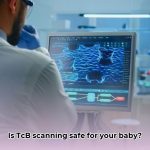Newborn jaundice is a common concern for new parents. This guide provides a complete overview of transcutaneous bilirubin (TcB) scans, a non-invasive method to check bilirubin levels in a baby’s skin. Understanding when a TcB scan is necessary and how to interpret the results is crucial for ensuring optimal care and minimizing potential complications associated with jaundice.
What is a TcB Scan?
A TcB scan, or transcutaneous bilirubinometry, is a quick and painless test used to estimate bilirubin levels in a newborn’s skin. Bilirubin is a yellow pigment produced during the normal breakdown of red blood cells. Newborns often have higher bilirubin levels because their livers are not yet fully developed to efficiently process and eliminate it. When bilirubin accumulates, it can cause jaundice, characterized by yellowing of the skin and eyes. Monitoring bilirubin levels is essential to prevent potential complications.
How Does TcB Work?
The TcB test utilizes a handheld device called a bilirubinometer. This device emits a light that penetrates the skin and measures the amount of light absorbed and reflected. The device then calculates the bilirubin level based on these measurements. The procedure is non-invasive, requiring no needles or blood samples, making it a preferred screening method for newborns.
When is a TcB Scan Recommended?
TcB scans are typically performed as part of routine newborn screening in hospitals and clinics. However, there are specific situations where a TcB scan is particularly recommended:
- Visible Jaundice: If a baby exhibits yellowing of the skin or eyes, a TcB scan is usually performed to assess the bilirubin level.
- Premature Infants: Premature babies are more likely to develop jaundice due to their immature livers. TcB scans are often used to monitor bilirubin levels in these infants closely.
- Risk Factors: Babies with certain risk factors, such as a family history of jaundice, bruising during birth, or feeding difficulties, may require more frequent TcB scans.
- Follow-Up: If an initial TcB scan shows elevated bilirubin levels, repeat scans may be performed to monitor the progression of jaundice and the effectiveness of any treatment.
- Before Discharge: Many hospitals perform a TcB scan before discharging a newborn to ensure that bilirubin levels are within a safe range.
Frequency of TcB Scans
The frequency of TcB scans depends on the individual baby’s risk factors, bilirubin levels, and overall health. Healthcare providers will determine the appropriate schedule for monitoring bilirubin levels based on these factors.
Factors Affecting TcB Reading Accuracy
Several factors can influence the accuracy of TcB readings. It is essential to be aware of these limitations to ensure proper interpretation of the results:
- Skin Pigmentation: Skin color can affect how the bilirubinometer reads bilirubin levels. Babies with darker skin may have less accurate TcB readings.
- Gestational Age: Premature infants may have different bilirubin metabolism rates, which can affect TcB accuracy.
- Device Calibration: Regular calibration of the bilirubinometer is crucial for accurate readings.
- Phototherapy: Recent phototherapy treatment can alter bilirubin levels in the skin, affecting TcB accuracy.
- Measurement Site: The location on the baby’s body where the measurement is taken can also influence the reading. Healthcare providers typically take measurements on the forehead or sternum.
To mitigate these factors, healthcare providers may take multiple readings and average them or use correction factors based on skin pigmentation.
TcB vs. Serum Bilirubin (TSB)
While TcB scans are a valuable screening tool, they are not a replacement for serum bilirubin (TSB) blood tests. TSB is considered the gold standard for measuring bilirubin levels accurately.
TcB scans are primarily used as a screening tool to determine if a TSB test is necessary. If a TcB scan indicates elevated bilirubin levels, a TSB test is usually performed to confirm the results and determine the exact bilirubin concentration in the baby’s bloodstream.
TSB tests involve drawing a small blood sample from the baby’s heel or arm. The blood sample is then sent to a laboratory for analysis. TSB tests provide a more precise measurement of bilirubin levels than TcB scans.
Balancing TcB and TSB
Healthcare providers balance the use of TcB and TSB to optimize patient care by using TcB as a first-line screening tool and reserving TSB tests for cases where TcB results are elevated or when a more accurate measurement is needed. This approach minimizes unnecessary blood draws while ensuring that babies with significant jaundice are identified and treated promptly.
Understanding TcB Results and Next Steps
Healthcare providers will explain the TcB results to parents and discuss the appropriate next steps based on the baby’s bilirubin levels and overall health.
Normal Bilirubin Levels
Normal bilirubin levels vary depending on the baby’s age in hours. Healthcare providers use standardized charts to interpret TcB results and determine if the bilirubin level is within the normal range for the baby’s age.
Elevated Bilirubin Levels
If a TcB scan reveals elevated bilirubin levels, the healthcare provider may recommend the following:
- TSB Test: A TSB test is usually performed to confirm the TcB results and determine the exact bilirubin level.
- Phototherapy: If the bilirubin level is significantly elevated, phototherapy may be recommended. Phototherapy involves exposing the baby to special blue light, which helps break down bilirubin in the skin.
- Increased Feeding: Frequent feeding can help promote bilirubin elimination through bowel movements.
- Monitoring: Close monitoring of bilirubin levels is essential to ensure that jaundice is resolving and that the baby is responding to treatment.
In rare cases, more intensive treatments, such as exchange transfusion, may be necessary to lower bilirubin levels rapidly.
Actionable Steps for Healthcare Providers and Parents
Here are some actionable steps that healthcare providers and parents can take to ensure the best possible care related to TcB scans and jaundice management:
For Healthcare Providers:
- Standardized Procedures: Implement standardized TcB testing procedures in hospitals and clinics to ensure consistency and accuracy.
- Appropriate Thresholds: Establish clear thresholds for bilirubin levels that trigger further testing or intervention, considering available resources and risk tolerance.
- Proper Training: Ensure that staff are well-trained in using and interpreting TcB readings.
- Parent Education: Provide parents with clear and concise information about jaundice, TcB scans, and treatment options.
For Parents:
- Ask Questions: Address any concerns about jaundice with your pediatrician and ask for clarification on test results.
- Keep Appointments: Follow up on all scheduled check-ups and tests.
- Observe Your Baby: Pay close attention to your baby’s skin color and report any concerns to your doctor promptly.
- Ensure Adequate Feeding: Frequent feeding helps promote bilirubin elimination.
Optimizing Transcutaneous Bilirubinometry Cutoff Values for Neonatal Jaundice Screening
Effective jaundice screening requires optimizing transcutaneous bilirubinometry (TcB) cutoff values. There are key takeaways to consider, including the use of different decision rules to identify babies needing further testing. No single rule is perfect; the best one depends on individual risk factors and care settings. Standardized guidelines and technological improvements are needed to ensure effective care for all infants.
Key Takeaways:
- Three different decision rules exist for transcutaneous bilirubin (TcB) tests, each with varying success in identifying babies needing further testing.
- These rules balance minimizing needless blood tests with ensuring no babies are missed who need treatment.
- No single rule is perfect; the best choice depends on the baby’s risk factors and where they’re being cared for (hospital vs. home).
Understanding Transcutaneous Bilirubin (TcB) Testing
Jaundice results from bilirubin buildup. Transcutaneous bilirubinometry (TcB) offers a quick way to estimate bilirubin levels using a device that shines light on the skin. It’s a non-invasive alternative to traditional blood tests (total serum bilirubin or TSB). Standardized guidelines and technological improvements remain essential to make this process as seamless as possible.
Three Approaches to TcB Cutoff Values
A study examined three methods for following up TcB readings with a TSB test:
- 75th Percentile on Bhutani Nomogram: Uses a chart to determine the level at which a more invasive TSB test is indicated.
- 70% of the Phototherapy Threshold: Babies whose TcB reaches 70% of the bilirubin level necessitating phototherapy (light treatment) warrant further investigation.
- Within 3 mg/dL of Phototherapy Threshold: Triggers a follow-up TSB test when the TcB value is within 3 mg/dL of phototherapy levels.
Comparing the Methods
Each approach minimizes blood draws, but they all miss babies who need treatment. The ideal cutoff depends on the situation. In a busy hospital, a higher threshold minimizes unnecessary blood tests. An outpatient setting might need a more sensitive approach. A study showed that using the 75th percentile on the Bhutani Nomogram can accurately identify 95% of infants requiring phototherapy. How do these methods compare in terms of cost-effectiveness and resource utilization?
| Method | Advantage | Disadvantage |
|---|---|---|
| 75th Percentile Bhutani Nomogram | Provides a standardized, widely accepted framework | Might miss some babies who need phototherapy. |
| 70% of Phototherapy Threshold | Directly links TcB to treatment threshold | Potentially higher |
- Water Wheel Electric Generator Provides Free Home Electricity - December 15, 2025
- Choosing the Right Portable Hydro Turbine for Your Needs - December 14, 2025
- Best Portable Hydro Generators for Off-Grid and Outdoor Power - December 13, 2025















